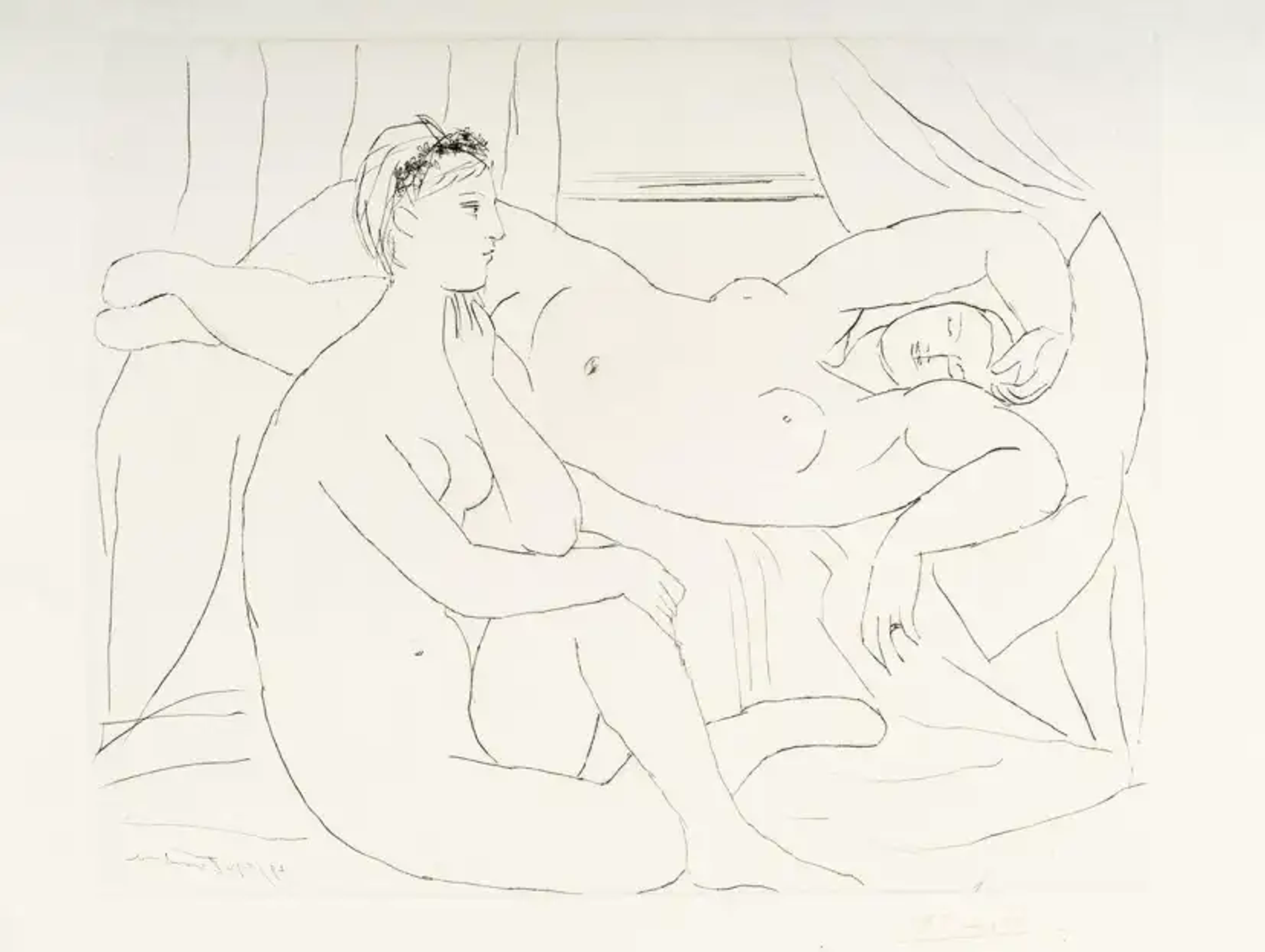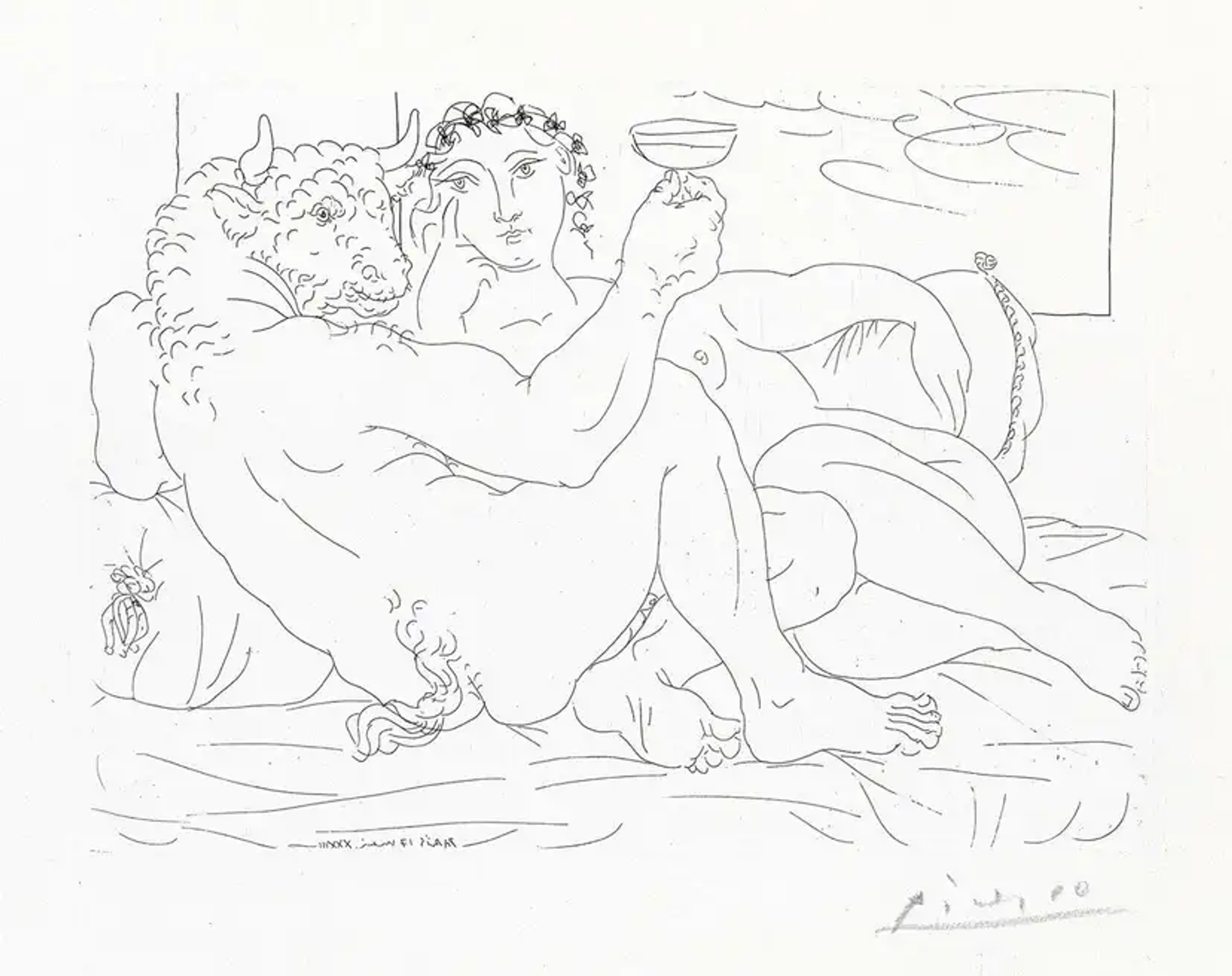 Image © Creative Commons via Flickr / Mére et Enfant © Pablo Picasso 1901
Image © Creative Commons via Flickr / Mére et Enfant © Pablo Picasso 1901
Pablo Picasso
160 works
Although Pablo Picasso is not necessarily renowned for the excellent treatment of women in his life, they are omnipresent in his art. He was particularly interested in the concept of motherhood, a fascination evident in his diverse portrayals of mothers, ranging from nurturing figures to symbols of fertility and strength. Throughout his career, Picasso explored the complexities of the mother-child relationship, embedding personal experiences and cultural influences into his work. His depictions offer a multifaceted view of motherhood, intertwining tenderness and sacrifice, highlighting the profound bond between mother and child and contributing a unique perspective to the discourse on maternity in art history.
The Role of Women in Picasso's Artistic Universe
Picasso's artistic universe is deeply entwined with the women who entered his life, serving as muses, lovers and the physical embodiments of his shifting artistic phases. These relationships were key sources of inspiration, fundamental to the evolution of his work – making the role of women in Picasso's art both crucial and enormously complex. Women, central to Picasso's creative process, acted as the catalysts for his innovation. They were more than just subjects to be painted; they were the manifestations of his artistic periods, influencing the mood, style and thematic direction of his work. Each woman in his life represented a distinct chapter, their presence and influence traceable in the evolution of his art. Picasso's interactions with these women were marked by intense emotional dynamics. His relationships were often tumultuous, fueled by his own deep narcissism and a passionate intensity that could be both creatively invigorating and personally destructive. This emotional turbulence is palpable in his artwork, where the depth of his feelings—ranging from love and reverence to anguish and conflict—is reflected.
The women in Picasso's life left indelible marks on his creative output. Their influence is so pronounced that one can map out Picasso's emotional and artistic journey through the shifts in his style and subjects brought about by his relationships with them. From the tender, melancholic tones of his Blue Period to the bold, innovative shapes of Cubism, each phase mirrors the impact these muses had on him, both personally and artistically. In examining Picasso's oeuvre, it is clear that the role of women transcends mere inspiration. They were integral to his artistic universe, shaping not only the content of his work but also its emotional and stylistic contours. Through the lens of his relationships with women, one gains insight into the complexity of his art, where the interplay of personal and creative spheres reveals a portrait of an artist for whom love, passion and art were inextricably linked.
Symbolism and Significance: Mothers in Picasso's Work
In art historical discourse, Picasso’s career is largely defined through his several stylistic periods. Motherhood is a subject that reoccurs throughout, and similarly follows the mood and ambiance of each period. This is particularly evident during the Blue Period (1901-1904), where motherhood emerges as a central and recurrent theme, contrary to perceptions of it being a marginal or secondary concern. Upon arriving in Barcelona in 1895, amidst the industrial changes and social turmoil of the fin de siècle, Picasso joined a group of anarchist-oriented artists. Influenced by Émile Zola's naturalism and the increasing social concerns of the era, the Blue Period is defined by a profound melancholy, portraying beggars, mothers with children, prostitutes, and bohemians in bars and cafés. Historians note that his Blue Period's maternal images were significantly influenced by his visit to the women's prison of Saint Lazare, an experience that deeply impacted him. These depictions of maternal figures—sad, melancholic, and skeletal, shut off from the world by their marginality—convey the stigma of poverty and loneliness. This portrayal of motherhood faced criticism within the elites, who viewed pregnancy as a grave risk and the children of single mothers as burdensome. The dark tones, severe lines and sombre style of these works underscore the misery and anxiety of mothers facing the responsibility of childrearing in poverty, often without paternal support.
With his move to Paris in 1904, Picasso's brief Rose period (1904-06) marked a significant shift in the dominant colour palette but also a more optimistic and serene mood. Motherhood in this more optimist era is epitomised by the painting Famille D'Acrobates Avec Un Singe (1905), where the child, cradled in its mother's arms, is fully integrated into a familial setting exuding harmony and both maternal and paternal love. The serene face of the young mother in this painting reflects an acceptance and understanding of her role, with the father figure, often absent in earlier works, now clearly part of the family unit. The depiction of motherhood reaches its zenith in Picasso's work during the 1920s, in his so-called neoclassical period. After visiting Italy and Greece in 1919, Picasso became deeply influenced by the classical ideal, with man as the focal point of the composition. This period also coincided with his meeting the Russian dancer Olga Khokhlova, with whom he had his first son, Paulo, in 1921. The portraits of Olga during this time evoke Renaissance Madonnas, with a contemporary twist.
Picasso increasingly moves away from the classical ideals of proportion and harmony towards voluminous and disproportionate bodies, starkly contrasting with the gaunt figures of the Blue period. The maternal body in this period is defined by its grace and sensuality, with the child, often disproportionately small compared to the mother's body, depicted as protected and cherished. This idealisation of the mother-child relationship is portrayed in an intimate world, closed off from the outside, with the mother and child occupying almost the entire canvas, presenting the child as an archetypal figure from the classical world. This period stands as a pinnacle in Picasso's portrayal of motherhood. In later decades, although motherhood themes recede to the background, his children become the main subjects. From this period onwards, the maternal image is conveyed through portraits of his children and in familial, everyday settings.
Cultural Influences on Picasso's Depiction of Motherhood
Picasso's artistic portrayal of motherhood is deeply infused with a tapestry of cultural influences that span his extensive career, intertwining with his unique vision to create rich, contextual representations of maternal figures. His Spanish heritage and the Catholic veneration of the Virgin Mary significantly coloured his early works with an aura of sanctity and maternal solemnity, reminiscent of the Madonna's revered image. This spiritual underpinning is juxtaposed with the stylised, abstract influences of African and Iberian art, which informed Picasso's revolutionary approach to form, especially evident in his Cubist explorations of the mother-child relationship through fragmented and reassembled figures. The neoclassical period, influenced by his travels to Italy, saw a return to the serene, idealised forms of classical art, imbuing his maternal subjects with a timeless, monumental quality that celebrated motherhood's beauty and strength.
Personal experiences and relationships with the women in his life added a deeply personal dimension, with the birth of his children marking new phases in his artwork and leading to more intimate depictions of maternal figures. This blend of personal narrative with broad cultural elements resulted in a portrayal of motherhood that was not only innovative but deeply human, capturing the universal themes of love, protection, and sacrifice through a uniquely Picasso-esque lens.
 Guernica © Pablo Picasso 1937
Guernica © Pablo Picasso 1937The Emotional Depth of Maternity in Picasso's Creations: The Case of Guernica
The relationship between a mother and child plays a crucial role even in one of his most famous creations, the 1937 monumental work Guernica, which stands as a powerful condemnation of the brutality of the Spanish Civil War. Within this monumental work, the motif of the mother and child takes on a harrowing significance, embodying the anguish and despair wrought by violence and loss. To the left of the composition, the figure of a grieving mother holding her dead child becomes a central symbol of the suffering and innocence destroyed by war. This image echoes the Christian representation of the Pietà, where Mary mourns the death of Jesus, yet Picasso's rendition is stripped of any sanctifying context, thrust into the chaos and horror of modern conflict. The mother's wide-open mouth, her eyes cast upwards in a silent scream, conveys an unbearable agony that transcends personal grief to represent a universal outcry against the atrocities of war. The limp, lifeless body of the child underscores the senseless loss of innocent lives, evoking a deep empathy and sorrow in the viewer.
Picasso's portrayal of maternity in "Guernica" transcends the physical connection between mother and child, delving into the emotional and psychological realms. The depiction is not just an illustration of maternal love but an exploration of the despair that such love can face in the shadow of inhumanity. It highlights the vulnerability and resilience inherent in the maternal bond, the instinctual urge to protect life amidst destruction, and the profound grief of losing what is most cherished. Through Guernica, Picasso communicates the profound impact of political and social turmoil on the individual and collective psyche, using the motif of motherhood to anchor the emotional resonance of the work. The maternal figure becomes a symbol of the capacity for suffering, the enduring human spirit and the need for relentless pursuit of peace and justice. In this context, the emotional depth of maternity in Picasso's creations is not only a reflection of personal affection but also a powerful commentary on the human condition, making a poignant statement on the sanctity of life and the tragedy of its loss.
The Unbreakable Bond: Reflecting on Picasso's Maternal Masterpieces
From the tender intimacies of his Blue and Rose periods to the stark anguish depicted in Guernica, Picasso's maternal figures are imbued with a depth of feeling that transcends the canvas, speaking to the universal experience of love, loss and resilience. These masterpieces showcase his unparalleled ability to capture the essence of human emotion but also underscore the sanctity and complexity of the maternal bond. Through his art, Picasso confronts us with the visceral realities of life and the unbreakable connections that define our existence, inviting reflection on the enduring power of motherhood to inspire, to nurture, and to endure amidst the ever-changing landscapes of history and culture.










